
Mouthwash, mouth rinse, oral rinse, or mouth bath is a liquid which is held in the mouth passively or swirled around the mouth by contraction of the perioral muscles and/or movement of the head, and may be gargled, where the head is tilted back and the liquid bubbled at the back of the mouth.

Listerine is an American brand of antiseptic mouthwash that is promoted with the slogan "Kills germs that cause bad breath". Named after Joseph Lister, who pioneered antiseptic surgery at the Glasgow Royal Infirmary in Scotland, Listerine was developed in 1879 by Joseph Lawrence, a chemist in St. Louis, Missouri.
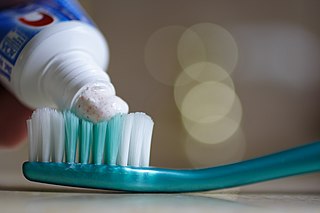
Toothpaste is a paste or gel dentifrice used with a toothbrush to clean and maintain the aesthetics and health of teeth. Toothpaste is used to promote oral hygiene: it is an abrasive that aids in removing dental plaque and food from the teeth, assists in suppressing halitosis, and delivers active ingredients to help prevent tooth decay and gum disease (gingivitis). Owing to differences in composition and fluoride content, not all toothpastes are equally effective in maintaining oral health. The decline of tooth decay during the 20th century has been attributed to the introduction and regular use of fluoride-containing toothpastes worldwide. Large amounts of swallowed toothpaste can be poisonous. Common colors for toothpaste include white and blue.
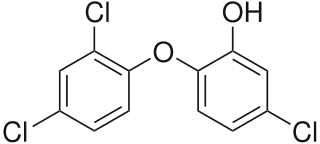
Triclosan is an antibacterial and antifungal agent present in some consumer products, including toothpaste, soaps, detergents, toys, and surgical cleaning treatments. It is similar in its uses and mechanism of action to triclocarban. Its efficacy as an antimicrobial agent, the risk of antimicrobial resistance, and its possible role in disrupted hormonal development remains controversial. Additional research seeks to understand its potential effects on organisms and environmental health.
Crest is an American brand of toothpaste and other oral hygiene products made by American multinational Procter & Gamble (P&G) and sold worldwide. In many countries in Europe, such as Germany, Bulgaria, Serbia, Ukraine, Belarus, Russia, Poland, Hungary, Latvia, Romania, Estonia and Lithuania, it is sold as Blend-A-Med, the name of an established German toothpaste acquired by P&G in 1987. In France, Italy, Israel, Sweden, Finland, Argentina, Belgium, the Netherlands, Brazil, the United Kingdom, the Republic of Ireland, Australia, Nigeria, Greece, Uruguay and Colombia, P&G markets similar toothpaste formulations under the Oral-B brand.
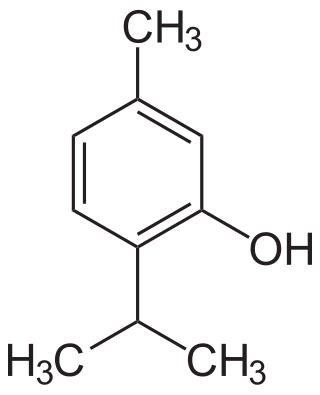
Thymol, C10H14O, is a natural monoterpenoid phenol derivative of p-Cymene, isomeric with carvacrol, found in oil of thyme, and extracted from Thymus vulgaris, ajwain, and various other plants as a white crystalline substance of a pleasant aromatic odor and strong antiseptic properties. Thymol also provides the distinctive, strong flavor of the culinary herb thyme, also produced from T. vulgaris. Thymol is only slightly soluble in water at neutral pH, but it is extremely soluble in alcohols and other organic solvents. It is also soluble in strongly alkaline aqueous solutions due to deprotonation of the phenol. Its dissociation constant (pKa) is 10.59±0.10. Thymol absorbs maximum UV radiation at 274 nm.
Pepsodent is an American brand of toothpaste with the minty flavor that is derived from sassafras. The brand was purchased by Unilever in 1942 and is still owned by the company outside of the United States and Canada. In 2003, Unilever sold the rights to the brand in the North American market to Church & Dwight.

Eugenol is an allyl chain-substituted guaiacol, a member of the allylbenzene class of chemical compounds. It is a colorless to pale yellow, aromatic oily liquid extracted from certain essential oils especially from clove, nutmeg, cinnamon, basil and bay leaf. It is present in concentrations of 80–90% in clove bud oil and at 82–88% in clove leaf oil. Eugenol has a pleasant, spicy, clove-like scent. The name is derived from Eugenia caryophyllata, the former Linnean nomenclature term for cloves. The currently accepted name is Syzygium aromaticum.
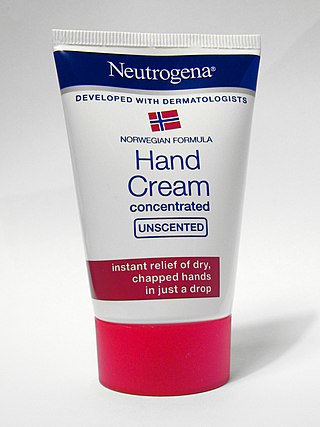
Neutrogena Corporation, trading as Neutrogena, is an American company that produces cosmetics, skin care and hair care and owned by parent company Kenvue and is headquartered in Los Angeles, California. According to product advertising at their website, Neutrogena products are distributed in more than 70 countries.

Hexachlorophene, also known as Nabac, is an organochlorine compound that was once widely used as a disinfectant. The compound occurs as a white odorless solid, although commercial samples can be off-white and possess a slightly phenolic odor. It is insoluble in water but dissolves in acetone, ethanol, diethyl ether, and chloroform. In medicine, hexachlorophene is useful as a topical anti-infective and anti-bacterial agent. It is also used in agriculture as a soil fungicide, plant bactericide, and acaricide.
Germolene is the brand name used on a range of antiseptic products produced by the Bayer company, who purchased the brand from SmithKline Beecham in 1999. It is manufactured for Bayer UK by the Devon based Wrafton Laboratories division of US over-the counter and supermarket own-label preparation producer Perrigo.
Ipana was a toothpaste manufactured by Bristol-Myers Company. The wintergreen-flavored toothpaste, with active ingredient 0.243% sodium fluoride, reached its peak market penetration during the 1950s in North America. Marketing of Ipana used a Disney-created mascot named Bucky Beaver in the 1950s.

Strepsils is a brand of throat lozenges manufactured by Reckitt. Strepsils throat lozenges are used to relieve discomfort caused by mouth and throat infections.

Lysol is a brand of American cleaning and disinfecting products distributed by Reckitt, which markets the similar Dettol or Sagrotan in other markets. The line includes liquid solutions for hard and soft surfaces, air treatment, and hand washing. The active ingredient in many Lysol products is benzalkonium chloride, but the active ingredient in the Lysol "Power and Free" line is hydrogen peroxide. Lysol has been used since its invention in the late 19th century as a household and industrial cleaning agent, and previously as a medical disinfectant.

Sensodyne is a brand name of toothpaste and mouthwash targeted at people with sensitive teeth. Sensodyne is owned by Haleon and is marketed under the name Shumitect in Japan.

Vicks VapoRub is a mentholated topical ointment, part of the Vicks brand of over-the-counter medications owned by the American consumer goods company Procter & Gamble. VapoRub is intended for use on the chest, back and throat for cough suppression or on muscles and joints for minor aches and pains. Users of VapoRub often apply it immediately before sleep.
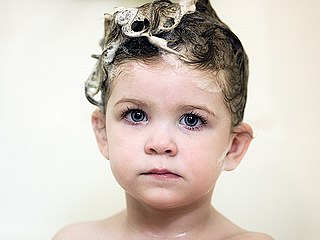
Shampoo is a hair care product, typically in the form of a viscous liquid, that is used for cleaning hair. Less commonly, shampoo is available in solid bar format. Shampoo is used by applying it to wet hair, massaging the product into the scalp, and then rinsing it out. Some users may follow a shampooing with the use of hair conditioner.

Zam-Buk is a patent medicine which was produced by the Zam-Buk Company of Leeds, England, founded by Charles Edward Fulford. It was first sold by his Bile Beans company in 1902, as a herbal balm and antiseptic ointment; the use of a complementary Zam-Buk soap was recommended to augment the treatment. The ointment was advertised as being effective against a wide range of conditions, including cuts, bruises, sprains, ulcers, bleeding piles and even colds and toothache. It could also be used as an embrocation by rubbing it into the muscles of the back, legs or feet.
Schmidt's Deodorant Company, LLC is an American personal care company based in Portland, Oregon. A subsidiary of Unilever, Schmidt's Naturals manufactures and sells plant and mineral-based personal care products including natural deodorant, soap, and toothpaste.













